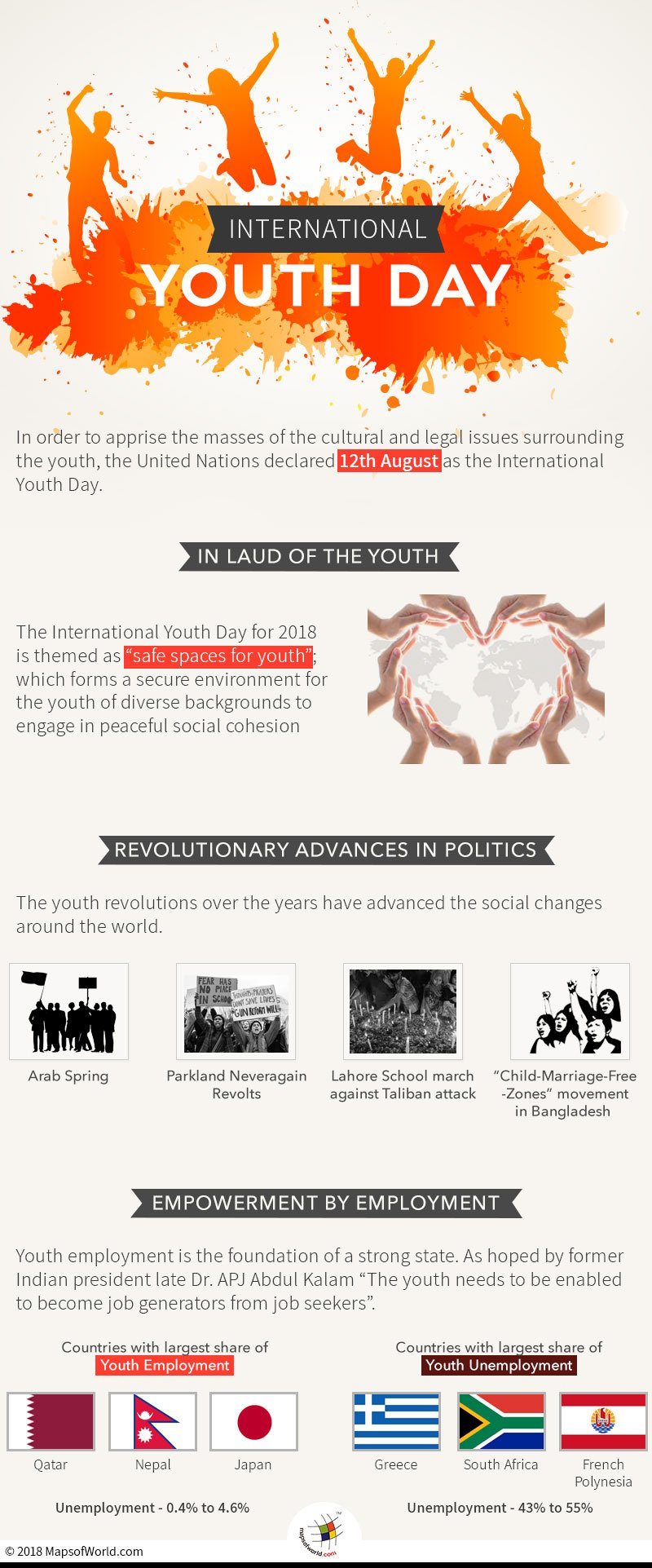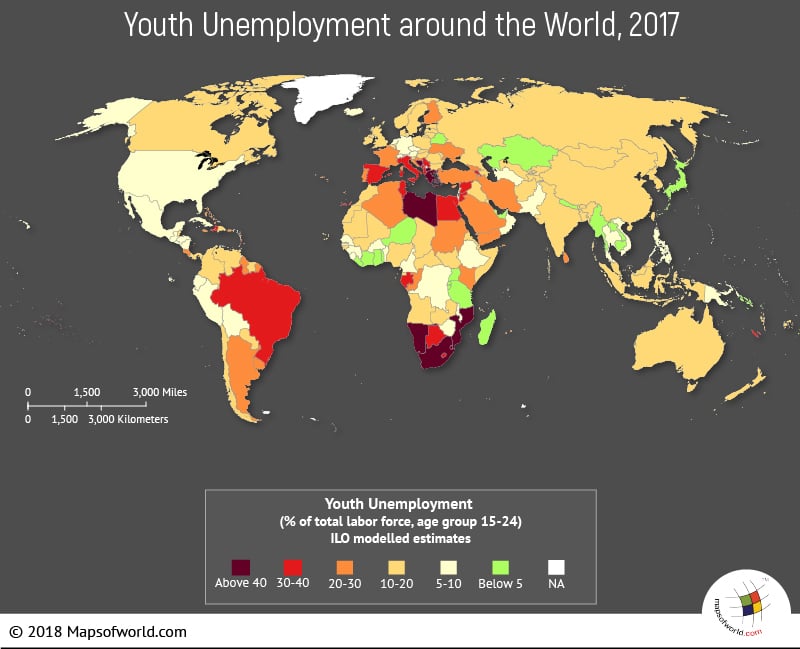What is International Youth Day?
The desires and hopes of today’s generation crafts the world’s tomorrows.
A nation’s rate of development, as well as the shape of its population pyramid, is largely determined by the population of its youth. It is the ‘expansive’ type of pyramid that has a larger percentage of people in the younger age groups, indicative of a fast rate of growth. In order to apprise the masses of the cultural and legal issues surrounding youth, the United Nations declared August 12th as International Youth Day.
The United Nations first session of the World Youth Forum recommended the conception of the International Youth Day to promote and support the issues concerning the youth of the world.
In Laud Of The Youth:
The theme for 2018 International Youth Day is ‘safe spaces for youth,’ incorporating civic, public and digital spaces. This broadband inclusion ensures engagement of the youth in governance by passive decision making at the domestic and global levels. This forms a secure environment for the youth of diverse backgrounds to engage in peaceful social cohesion.
Revolutionary Advances In Politics:
Youth revolutions over the years have advanced social changes around the world. From the Arab Spring to the recent Parkland #neveragain revolts, the timeline depicts a clear pattern of bold and fundamental concerns expressed by the young generation. The South Asian region hasn’t remained unstirred. The movements in Bangladesh for ‘child-marriage-free-zones,’ the school march in Lahore against the Taliban attack, and the global march against child labor in India are all inspiring and galvanizing.
The digital era has led to mass implications and helped in bridging the gap between the dream of a hopeful youth and the existential unequal opportunities.
Empowerment By Employment:
Youth employment is the foundation of a strong state. As hoped by former president, the late Dr. APJ Abdul Kalam “The youth needs to be enabled to become job generators from job seekers.” The United Nations defines ‘youth’ as those persons between the age of 15 and 24. An unemployed person is defined as someone who does not have a job and is actively seeking one. The rate of unemployment is calculated as the number of employed persons, divided by, the total labor force (both unemployed and employed between the age group of 15-24).
This potential workforce directly impacts the structural and functional economy. It is also called a ‘lost generation’ owing to productivity and skill sets lost.
Countries like Qatar, Nepal, and Japan have the largest share of youth employed. Their rate of unemployment is ranging from 0.4%-4.6% whereas Greece, South Africa, and French Polynesia have their largest share of youth unemployed varying between 43%-55%. The external factors like the financial crisis when intertwined with the prevailing unemployment problems in labor and education system, push these countries into the lowest levels. Mid-ranging countries with a growing population, due to high fertility rates and low mortality rates, show concerns of creating insufficient employment opportunities. These countries have a higher dependency ratio, further pressurizing the available resources.
International Organizations At Play:
In a globalized economy with the fast movement of resources, the undervalue of the human resource would mean a failure in the optimization of the future. This vision is reflected in ILO’s youth employment program, where it commits a tripartite structure to resolve the problem of youth unemployment. Similarly, the goal 8 (.6) of the 2030 Agenda for Sustainable Development adopted by the United Nations Sustainable Development Summit, works on bringing an end to youth unemployment crisis.
These efforts have shifted the younger generations from mere passive objects to the torch bearers of an inclusive, growth-ridden economy.
Underlying table depicts the rate of unemployment in different countries.
| Country | Unemployment rate ILO modelled estimates(%)Total |
Country | Unemployment rate ILO modelled estimates(%)Total |
|
| French Polynesia | 55.6 | Bulgaria | 13 | |
| Bosnia and Herzegovina | 54.9 | Gambia | 12.9 | |
| Eswatini | 54.8 | Moldova | 12.8 | |
| South Africa | 53.5 | New Zealand | 12.8 | |
| Macedonia | 47 | Australia | 12.6 | |
| Libya | 46 | Guam | 12.5 | |
| Namibia | 45.5 | Dominican Republic | 12.4 | |
| Saint Lucia | 45 | Estonia | 12.2 | |
| Greece | 43.6 | United Kingdom | 12.1 | |
| Occupied Palestinian Territory | 43 | Panama | 12 | |
| Mozambique | 42.7 | Djibouti | 11.7 | |
| Jordan | 39.8 | North Korea | 11.7 | |
| Saint Vincent and the Grenadines | 39.6 | Canada | 11.6 | |
| Spain | 38.8 | Guinea-Bissau | 11.6 | |
| Armenia | 38.6 | Timor-Leste | 11.6 | |
| Lesotho | 38.5 | Bangladesh | 11.4 | |
| New Caledonia | 38.1 | Trinidad and Tobago | 11.4 | |
| Tunisia | 36.3 | Eritrea | 11.3 | |
| Haiti | 36 | Slovenia | 11.3 | |
| Gabon | 35.9 | Denmark | 11 | |
| Botswana | 35.7 | Somalia | 11 | |
| Syrian Arab Republic | 35.1 | Malaysia | 10.9 | |
| Italy | 34.7 | China | 10.8 | |
| Egypt | 34.4 | Hungary | 10.7 | |
| Serbia | 32.8 | Paraguay | 10.7 | |
| Montenegro | 31.8 | Central African Republic | 10.6 | |
| Brazil | 30.2 | Vanuatu | 10.6 | |
| Albania | 30 | India | 10.5 | |
| Iran | 29.9 | Malta | 10.5 | |
| Jamaica | 29.7 | Norway | 10.3 | |
| Barbados | 29 | Bhutan | 10.2 | |
| Georgia | 28.8 | South Korea | 10.2 | |
| Brunei Darussalam | 28.2 | Taiwan, China | 10.2 | |
| Croatia | 27.4 | Chad | 10.1 | |
| Sudan | 27.3 | Comoros | 10 | |
| Kenya | 26.2 | Austria | 9.8 | |
| Bahamas | 25.7 | El Salvador | 9.8 | |
| Yemen | 25.7 | United States | 9.2 | |
| Saudi Arabia | 25 | Sierra Leone | 9 | |
| Uruguay | 24.8 | Cameroon | 8.9 | |
| Mauritius | 24.5 | Netherlands | 8.9 | |
| Algeria | 24.3 | Hong Kong | 8.7 | |
| Portugal | 23.9 | Nicaragua | 8.7 | |
| Cyprus | 23.8 | Burkina Faso | 8.6 | |
| Argentina | 23.5 | Peru | 8.6 | |
| Ukraine | 23.3 | Ecuador | 8.5 | |
| Puerto Rico | 23 | Oman | 8.5 | |
| Congo | 22.5 | Honduras | 8.2 | |
| France | 22.1 | Zimbabwe | 8.2 | |
| Guyana | 21.6 | Switzerland | 8.1 | |
| Costa Rica | 21 | Czech Republic | 8 | |
| Sri Lanka | 20.7 | Malawi | 7.8 | |
| Sao Tome and Principe | 20.6 | Pakistan | 7.7 | |
| Turkey | 20.3 | Iceland | 7.6 | |
| Finland | 20 | Ethiopia | 7.4 | |
| Belize | 19.8 | Democratic Republic of the Congo | 7.3 | |
| Western Sahara | 19.8 | Israel | 7.3 | |
| Belgium | 19.2 | Viet Nam | 7 | |
| Angola | 19.1 | Germany | 6.8 | |
| Channel Islands | 19 | Mexico | 6.8 | |
| Slovakia | 19 | Philippines | 6.8 | |
| Mongolia | 18.9 | Bolivia | 6.5 | |
| Tajikistan | 18.9 | Turkmenistan | 6.5 | |
| Fiji | 18.8 | Thailand | 5.9 | |
| Romania | 18.5 | Guatemala | 5.8 | |
| Colombia | 18.1 | Bahrain | 5.5 | |
| Mali | 18 | Cuba | 5.5 | |
| Morocco | 18 | Guinea | 5.5 | |
| Samoa | 18 | Senegal | 5.5 | |
| Mauritania | 17.9 | Benin | 5.2 | |
| Cape Verde | 17.8 | Papua New Guinea | 5 | |
| Sweden | 17.8 | Ghana | 4.9 | |
| Afghanistan | 17.7 | United Arab Emirates | 4.9 | |
| Lebanon | 17.6 | Japan | 4.6 | |
| South Sudan | 17.6 | Singapore | 4.6 | |
| Chile | 17.2 | Kazakhstan | 4.5 | |
| Venezuela, Bolivarian Republic of | 17.1 | Macau, China | 4.5 | |
| Latvia | 17 | Solomon Islands | 4.4 | |
| Iraq | 16.8 | Nepal | 4.3 | |
| United States Virgin Islands | 16.8 | Tanzania, United Republic of | 3.9 | |
| Russian Federation | 16.3 | Côte d’Ivoire | 3.7 | |
| Kuwait | 16 | Liberia | 3.3 | |
| Suriname | 15.9 | Madagascar | 3 | |
| Kyrgyzstan | 15.7 | Burundi | 2.9 | |
| Zambia | 15.4 | Uganda | 2.9 | |
| Indonesia | 15.2 | Togo | 2.8 | |
| Luxembourg | 15.2 | Tonga | 2.6 | |
| Poland | 14.8 | Rwanda | 2.1 | |
| Uzbekistan | 14.6 | Laos | 1.7 | |
| Equatorial Guinea | 14.2 | Myanmar | 1.7 | |
| Azerbaijan | 13.8 | Belarus | 1.1 | |
| Maldives | 13.8 | Niger | 0.5 | |
| Ireland | 13.6 | Cambodia | 0.4 | |
| Nigeria | 13.4 | Qatar | 0.4 | |
| Lithuania | 13.2 |
Know more:
Related maps:




